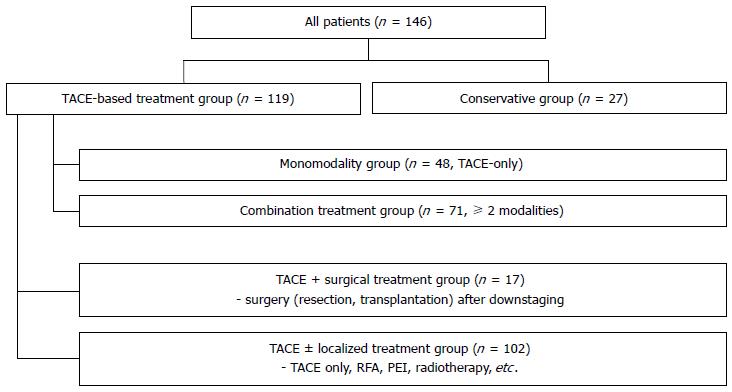Copyright
©The Author(s) 2015.
World J Gastroenterol. Feb 28, 2015; 21(8): 2395-2404
Published online Feb 28, 2015. doi: 10.3748/wjg.v21.i8.2395
Published online Feb 28, 2015. doi: 10.3748/wjg.v21.i8.2395
Figure 1 Treatment protocol.
TACE: Transarterial chemoembolization; RFA: Radiofrequency ablation; PEI: Percutaneous ethanol injection.
Figure 2 Overall survival according to the Kaplan-Meier method.
Significantly better overall survival rates were observed in the treatment group compared with the conservative group (P < 0.001) (A), in the surgical treatment group compared with the loco-regional treatment group (P < 0.001) (B), and in the multi-modal treatment group compared with the single modality group (P = 0.002) (C).
Figure 3 Representative example of multi-modal treatment.
A: A 46-year-old male patient had a large hepatocellular carcinoma measuring 11 cm in diameter in the right hepatic lobe; B: TACE was performed; C: After 6 sessions of TACE, 7 sessions of PEI, 6 cycles of systemic chemotherapy, and external radiation therapy, the tumor mass was remarkably reduced; D: After right hepatectomy, 2 cycles of adjuvant chemotherapy were administered. However, two metastatic nodules occurred, one in each lung without hepatic recurrence at 5 mo after right hepatectomy (arrow); E: Wedge resection for metastatic lung nodules was performed, and no hepatic and pulmonary recurrences were observed until 12 years after hepatectomy and metastasectomy (arrow). TACE: Transarterial chemoembolization; PEI: Percutaneous ethanol injection.
- Citation: Song DS, Nam SW, Bae SH, Kim JD, Jang JW, Song MJ, Lee SW, Kim HY, Lee YJ, Chun HJ, You YK, Choi JY, Yoon SK. Outcome of transarterial chemoembolization-based multi-modal treatment in patients with unresectable hepatocellular carcinoma. World J Gastroenterol 2015; 21(8): 2395-2404
- URL: https://www.wjgnet.com/1007-9327/full/v21/i8/2395.htm
- DOI: https://dx.doi.org/10.3748/wjg.v21.i8.2395











